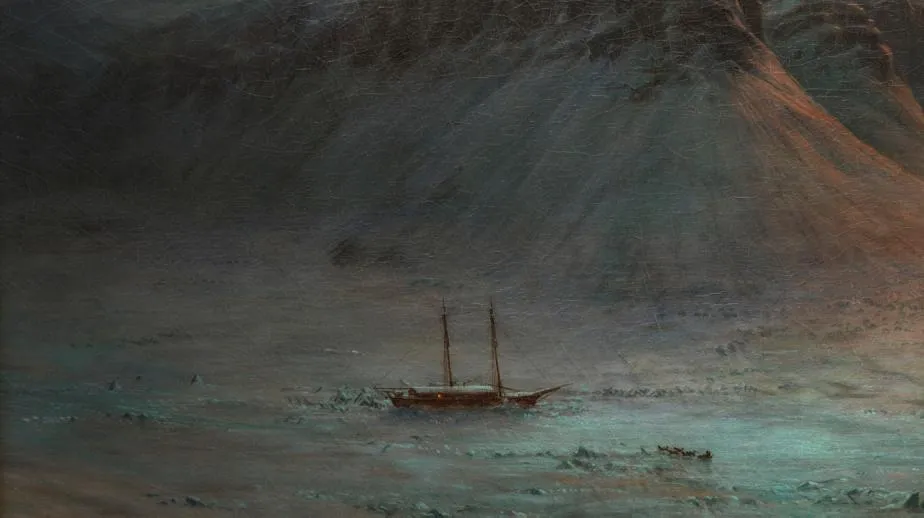The Crazy Superstitions and Real-Life Science of the Northern Lights
In the latest episode of ‘Re:Frame,’ Smithsonian curators take a deep dive into the dramatic painting ‘Aurora Borealis’ by Frederic Church
/https://tf-cmsv2-smithsonianmag-media.s3.amazonaws.com/filer/74/b3/74b382ae-bfb3-4627-bfd6-152af947506f/saam-191141_2-000001.jpg)
In 1859, a record-breaking aurora borealis shimmered across nearly the entire northern hemisphere and was visible as far south as Cuba. One of the witnesses to this historic heavenly display was the artist Frederic Edwin Church, who saw the event from New York City.
One of the 19th century’s most celebrated landscape painters, Church was also a “science nerd,” according to Eleanor Jones Harvey, the senior curator at the Smithsonian American Art Museum. In Church’s estimation, the study of science and the creation of art went hand-in-hand. “One of the things that makes Church so charming is that he did believe as an artist that you should also aspire to be a scientist and really know your material,” says Harvey.
A new episode of the museum’s web series “Re:Frame” takes a look at the dramatic convergence of solar science, arctic exploration, the Civil War and American art in Church’s 1865 painting Aurora Borealis.
Church counted among his friends many scientists and technological innovators, such as Cyrus Field, the creator of the transatlantic cable, and explorer Isaac Israel Hayes, whose 1861 arctic expedition is memorialized in Aurora Borealis. In fact, Hayes shared his sketches from the expedition with Church, who used them to draft his scene of Hayes’s ship stranded in the frozen arctic waters.
In the painting, a faint but visible light emanates from a window in the schooner. A dogsled team can be seen approaching the ship, though the fate of its crew is far from certain. While this dramatic rescue scene plays out in the foreground, a magnificent blue, orange and red aurora blankets the otherwise dark and immense sky in the top half of the painting.
The massive aurora that Church witnessed in 1859 was not his first encounter with the northern lights, nor would it be his last. In fact, conspicuous auroras, comets and meteors were not uncommon during this time period; and because of the charged political climate of the Civil War era, for Church and his contemporaries, the appearance of an atmospheric phenomena in the sky presaged something of significance.

During this unsettling time, anxiety and uncertainty hung like ether over a public that viewed these “nocturnal, unhinged rainbows,” as Harvey calls auroras in her book The Civil War and American Art, as divine omens.
“Auroras are weird, however, because they’re kind of a malleable portent,” she adds. “They can mean what you want them to mean.” For example, in the North, when the Union appeared to be winning the war, an aurora in the night sky was viewed as a talisman of God’s favor. By contrast, when the war seemed to be going in a less favorable direction, another aurora was deemed a portent of doom, a sign that the world was ending. In the absence of the scientific understanding of the phenomenon, these superstitious interpretations were given even more space in the collective understanding of the day.
Auroras are “a manifestation of what we now call space weather,” says David DeVorkin, the senior curator of the history of astronomy and the space sciences at the Smithsonian’s National Air and Space Museum. Just as meteorologists study conditions in our atmosphere in order to forecast the weather, space weather scientists study conditions in our solar system, some of which are known to produce effects visible on earth.
“The Earth’s atmosphere is reacting to very high energy particles coming from the sun, when the sun burps, you might say,” says DeVorkin. These particles are then caught by the Earth’s magnetic field, which “focuses them in the northern and very far southern latitudes.” The dynamic motion, characteristic of an aurora, is due to the fact that “the particles themselves are moving along,” he says.
“An aurora will wave, it will jump, it will flicker,” says DeVorkin, “They happen to be pretty.”
/https://tf-cmsv2-smithsonianmag-media.s3.amazonaws.com/filer/94/11/9411eb3a-4101-4879-b3db-da6136a1ee6c/s_npg_77_144-church-r.jpg)
While the magnificence of auroras in Church’s time—well documented not only in newspapers, magazines and scientific journals but also in poems and, of course, art—resonates with us in the 21st century, the unsettling feeling that accompanied the presence of auroras during the Civil War era situates Aurora Borealis in an unparalleled historical moment.
When Frederic Church began work on this painting in 1864, says Harvey, “it’s not 100 percent clear that the Union is going to win. We don’t really know how this is going to turn out.”
In this way, the aurora that Church includes in his painting represents a dramatic tension like the one playing out in the drama of Hayes’s stranded ship—which was, fittingly, named the SS United States. What’s ultimately going to happen? Will the Union endure? And if so, what will the reunited United States look like? It’s all TBD.
Ultimately, Church’s Aurora Borealis is, Harvey points out, “a cliffhanger.”
Frederic Edwin Church's 1865 Aurora Borealis is on view on the second floor, east wing of the Smithsonian American Art Museum in Washington, D.C.
/https://tf-cmsv2-smithsonianmag-media.s3.amazonaws.com/accounts/headshot/Anne-Showalter.jpg)
/https://tf-cmsv2-smithsonianmag-media.s3.amazonaws.com/accounts/headshot/Anne-Showalter.jpg)